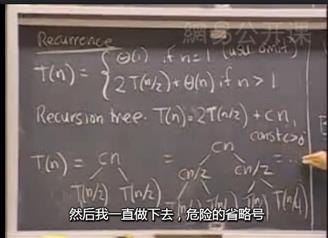Mit Algorithm tutorial 1
Posted
tags:
篇首语:本文由小常识网(cha138.com)小编为大家整理,主要介绍了Mit Algorithm tutorial 1相关的知识,希望对你有一定的参考价值。
//算法是一个程序员的基础,也是重中之重,我希望能重头系统的学习一遍算法。
Analysis of Algorithm
在程序领域,what‘s more important than the perfermance?
正确性,简洁性,健壮性。features,模块化,security, user friendly。
如果这些都比性能重要,那为什么我们还要学习性能和算法呢?
性能在很多时候,是用户体验的保证,
1,性能的好与坏,可能决定程序的可行于不可行。
2,算法是一种描述程序行为的语言。
3,是用户体验和安全的保障。
4,性能相当于一种货币,是一种标准和基础。
5,算法是一种刺激的东西。
startup with a simple problem
Sorting:
Input Array <a1, a2, ...,an> of number s.
Output permutation <a1‘, a2‘, ..., an‘> a1‘ <= a2’ <= ...<= an;
Insertion sort:
1 void InsertionSort(vector<int>& nums, int n) 2 { 3 int key; 4 //插入排序 5 //每一个pass,在有序数列0 - i-1 中插入第i个元素 6 for (int i = 1; i < n; ++i) 7 { 8 key = nums[i]; 9 for (int j = i - 1; j >= 0; --j) 10 { 11 if (nums[j] >= key) 12 { 13 //比key大的向前挪一位 14 nums[j + 1] = nums[j]; 15 if (j == 0) nums[j] = key; 16 } 17 else 18 { 19 nums[j + 1] = key; 20 break; 21 } 22 23 24 } 25 } 26 }
issue of the running time:
1,depend on the input itself.(e.g. already sorted)
2,depend on the input size.(6 elem VS. 6^9 elem)
3,Want upper bounds.(guarantee to the users)
Kinds of analysis
Worst case:(Usually)
T(n) = max time on any input of size n;
Average case:(Sometimes)
T(n) = expected time over all inputs of size n;
Best case:(bogus)
What is the sort‘s w-c time:
Depends on your computer;
relative speed (on same machine)
absolute speed (on diff machine)
Big Idea:渐进分析
1,Ignore the machine dependent
2,look at growth of T(n) n -> 无穷
θ :弃去低阶项,并忽略前面的常熟因子
当n趋近于无穷大的时候,性能只受到最高项的影响。(可以做到忽略不同计算机上性能的影响,消除特异性的麻烦)
Insertion sort :T(n) = ∑(from 2 - n) j = 1 + 2 + 3 + 4 ... = θ(n^2)
is insertion sort fast?
Merge sorting: A[1, 2, .. , n]
1 if n = 1, done;-----------------------------------------------------θ(1)
2 Recursively sort A[1, 2, .. , [n/2]] and A[[n/2]+1, .., n];-----2θ(n/2)
3 Merge sorted list--------------------------------------------------θ(n)
递归树

 the height of the tree is lg(n) the work of each level is Cn, So the total work is Theta(nlgn)
the height of the tree is lg(n) the work of each level is Cn, So the total work is Theta(nlgn)
void Merge(vector<int>& nums, int begin, int half, int end) { int n1, n2; int *left = NULL, *right = NULL; n1 = half - begin + 1; n2 = end - half; left = (int *)malloc(sizeof(int) * n1); right = (int *)malloc(sizeof(int) * n2); for (int i = 0; i < n1; i++) { left[i] = nums[begin + i]; } for (int j = 0; j < n2; j++) { right[j] = nums[half + 1 + j]; } int k = begin; int i = 0, j = 0; while (i < n1 && j < n2) { if (left[i] > right[j]) { nums[k++] = right[j++]; } else { nums[k++] = left[i++]; } } for (; i < n1; i++) { nums[k++] = left[i]; } for (; j < n2; j++) { nums[k++] = right[j]; } } void MergeSort(vector<int>& nums, int begin, int end) { int half = (end - begin) / 2; if (begin < end){ MergeSort(nums, begin , begin + half); MergeSort(nums, begin + half + 1, end); Merge(nums, begin, begin + half, end); } }
以上是关于Mit Algorithm tutorial 1的主要内容,如果未能解决你的问题,请参考以下文章